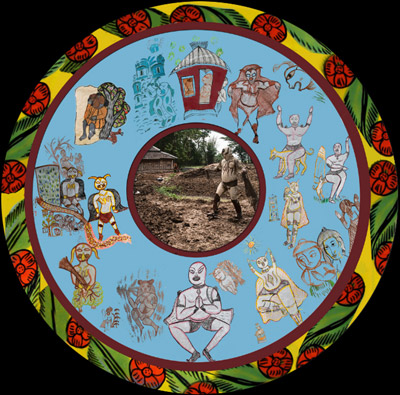
| HOME |
| NERVE |
| REVIEWS |
| ARCHIVE |
| EVENTS |
| LINKS |
| ABOUT US |
| CONTRIBUTORS |
| BACK ISSUES |
| CONTACT US |
 Flux,
Oxymorons and Dissent
Flux,
Oxymorons and Dissent
Liverpool Artists Tony Knox and Ruth Dillon have just returned from a
3 week residency in India, co-ordinated by Liverpool NGO PAX. The initial
aim of the residency was to forge a link with the tribal Patua painters,
based in a small village in Pingla, West Bengal. Knox and Dillon's work
was inspired in response to their experience in the village.
Traditionally the Patua paint in scroll form,a visual story, relayed by
single frames and multiple frames, painted with natural colours garnered
from flowers and herbs. The Patua scroll is considered to be the first
audio visual mode of storytelling in the in the world, dating from the
8th century Bc. As the scroll is unfurled, the painter sings the story
which can range from traditional to mythological and even more contemporary
subjects, such as Tsunami or even 9.11.
Ten Artists were selected to take part in multi-disciplinary workshops and an exhibition in Delhi. A 4 day workshop culminated in an amalgamation of ideas and an exchange of creative practice, resulting in an exhibition. This showcased eight masters of the Patua style, who have exhibited internationally and the two British Artists Dillon and Knox.
In the South Delhi gallery space: Mulk Raj Arnand Centre, Lokayukta, Knox and Dillon interpreted and presented their experiential exchange in quite different ways. Knox aka Mothman decided to create a visual paradox. On one hand, the artist Tony Knox created a mandala like space. The story of the mandala, like any logbook of a bohemian/traveller/drifter/ship-wrecked sailor has neither any beginning nor any end. It is about the mothman who stumbles on to a village landscape-negotiates the paddy fields-encounters layers of physical and spiritual darkness-and then sees his reflection on the moon-he is re-affirmed that reflections can indeed be shaped-and goes back to the landscape re-energised-soon after as he wanders across the paddy field both the images of bounty and replenishment stalks him and there he is like a true subject of the mandala spinning eternally on this axis of complete satisfaction and half-fulfilment....
Knox initiated and invited a dialogue, where the Patachitra artistes grappled with their recollections of the Mothman fairy-tale as envisioned and shaped by them. On the other hand, that crafted mythology (created in Pingla, with an intervention by Knox as mothman) was also tinged with irony. The irony or the dry wit that makes folk artistes so semiotically evolved (unlike the manicured cleverness of urban art where implied sub-text dominates the accidental sub-text).....and that potent black humour is reflected in the mandala or even the painted circus-of-the-round. The Mothman stalks the landscape....he becomes the lizard, blizzard, limp, blimp and profuse both in his decadence and modernity. Knox's work is in sharp contrast with Dillon's.
Dillon’s installationscape is about the conflict of memories. Both real and imagined. The cluster of kids playing out the pebble games...the five pebble throw of the dice...juxtaposed with the images of childhood, freeze frames of reality and that constant tussle between the “market” of the tradition and the tradition of the “market.” The tradition of the market would mean productivity of time and yet the bohemian flourish of time is what makes us creatively dissident...the basic rationale of drifting is what makes tradition subvert the market, re-orient the grammar and re-create the islands of dissidence amongst apparent manicured calm:
Dillons work is concept driven, primarily working with documentary aesthetics, Dillon uses stop frame and site sourced sound scapes. Working from photographic stills, Dillon archives the project, then projects the archive. Who are these children in the video? Pingla, Granby or Tower Hamlets, or a displaced Bangladeshi kid in Brick Lane trying to count his/her fortune inside a claustrophobic cell....as the mother awaits the license to stay or face imminent deportation..of course the children are from Pingla but then that is not the point....the point is the rationale behind globalisation reaching them: the cellphone, but delaying them the natural process of getting equal access to skill-based education.